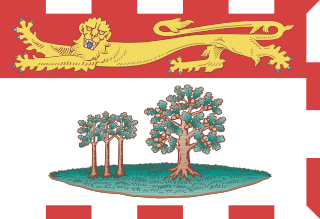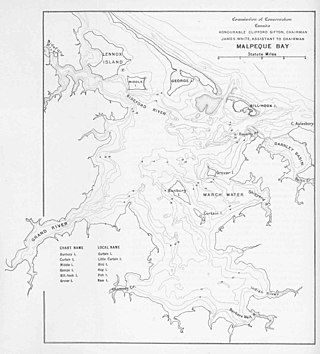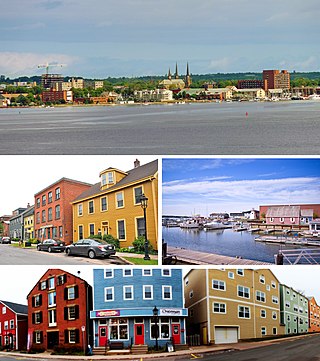
Prince Edward Island is an island province of Canada. While it is the smallest province in terms of land area and population, it is the most densely populated. The island has several nicknames: "Garden of the Gulf", "Birthplace of Confederation" and "Cradle of Confederation". Its capital and largest city is Charlottetown. It is one of the three Maritime provinces and one of the four Atlantic provinces.

The Magdalen Islands are an archipelago in the Gulf of St. Lawrence. Since 2005, the 12-island archipelago is divided into two municipalities: the majority-francophone Municipality of Îles-de-la-Madeleine and the majority-anglophone Municipality of Grosse-Île, in the Gaspésie–Îles-de-la-Madeleine region, Quebec, Canada.

The Northumberland Strait is a strait in the southern part of the Gulf of Saint Lawrence in eastern Canada. The strait is formed by Prince Edward Island and the gulf's eastern, southern, and western shores.

Prince Edward Island National Park is a National Park of Canada located in the province of Prince Edward Island. Situated along the island's north shore, fronting the Gulf of St. Lawrence, the park measures approximately 60 km (37 mi) in length and ranges from several hundred metres to several kilometres in width. Established in 1937, the park's mandate includes the protection of many broad sand beaches, sand dunes and both freshwater wetlands and saltmarshes. The park's protected beaches provide nesting habitat for the endangered piping plover; the park has been designated a Canadian Important Bird Area.

The 2003 Prince Edward Island general election was held on September 29, 2003 to elect the 27 members of the Legislative Assembly of Prince Edward Island. The election was called on September 2 by Premier Pat Binns, who enjoyed a high level of popularity among voters.

Summerside is a Canadian city in Prince County, Prince Edward Island. It is the second largest city in the province and the primary service centre for the western part of the island.

The Prince Edward Island Railway (PEIR) was a historic Canadian railway in Prince Edward Island (PEI). The railway ran tip-to-tip on the island, from Tignish in the west to Elmira in the east, with major spurs serving Borden-Carleton's train ferry dock, the capital in Charlottetown, Montague and Georgetown and the original eastern terminus at Souris. A major spur from Charlottetown served Murray Harbour on the south coast.

Tignish is a Canadian town located in Prince County, Prince Edward Island.

Norderney is one of the seven populated East Frisian Islands off the North Sea coast of Germany.
The Halifax Regional Municipality (HRM) in Nova Scotia, Canada has a widely varied geography.

North Rustico is a Canadian town located in Queens County, Prince Edward Island.
Alberton is a Canadian town located in Prince County, Prince Edward Island. It is situated in the western part of the county in the township of Lot 5.

The geography of Toronto, Ontario, covers an area of 630 km2 (240 sq mi) and is bounded by Lake Ontario to the south; Etobicoke Creek, Eglinton Avenue, and Highway 427 to the west; Steeles Avenue to the north; and the Rouge River and the Scarborough–Pickering Townline to the east. In addition to Etobicoke Creek and the Rouge River, the city is trisected by two minor rivers and their tributaries, the Humber River in the west end and the Don River east of downtown. Both flow southward to Lake Ontario at Humber Bay and Toronto Harbour respectively, which are part of the longer Waterfront, as well as Etobicoke Creek and the Rouge River.

Georgetown is a community located within the municipality of Three Rivers in Kings County, Prince Edward Island, Canada. It is the Capital of Kings County. Previously incorporated as a town, it amalgamated with the town of Montague, the rural municipalities of Brudenell, Cardigan, Lorne Valley, Lower Montague, and Valleyfield, and portions of three adjacent unincorporated areas in 2018.

White Juan is the unofficial name given to the hurricane-strength nor'easter blizzard of February 2004 that affected most of Atlantic Canada and the Eastern United States between February 17 and 20, 2004—five months after Hurricane Juan devastated Nova Scotia and Prince Edward Island.

Malpeque Bay is a 204 km2 (79 sq mi) estuarine bay on the north shore of Prince Edward Island, Canada.

Charlottetown is the capital and largest city of the Canadian province of Prince Edward Island, and the county seat of Queens County. Named after Queen Charlotte, Charlottetown was an unincorporated town until it was incorporated as a city in 1855.
South Bay is a waterway in the Kivalliq Region, Nunavut, Canada. It is located in Hudson Bay, off southwestern Southampton Island. It is west of Native Bay. The Kirchoffer River empties into the bay.

The Island Storm is an inactive Canadian professional basketball team based in Charlottetown, Prince Edward Island. The team is a charter member of the National Basketball League of Canada that began play in the 2011–12 season. The Storm plays its home games at the Eastlink Centre. Former Vermont Frost Heaves head coach Joe Salerno served as the team's head coach for the first six seasons until he parted ways with the team in May 2017. In 2021, the Storm were granted a one-year leave of absence after they were the last remaining team based in the Maritimes.

Nova Scotia lies in the mid-temperate zone, and although the province is almost surrounded by water, the climate is closer to continental climate rather than maritime climate. The temperature extremes of the continental climate are moderated by the ocean.




















